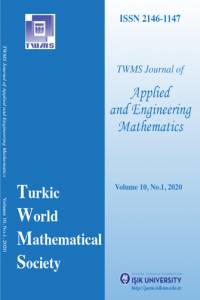BLIND DECONVOLUTION USING SHEARLET -TV REGULARIZATION
In this article we propose two minimization models for blind deconvolution. In the rst model, we use shearlet transform as a regularization term for recovering image. Also total variation method is used as a regularization term for point spread function PSF . To speed up the process, Fast ADMM approach is exploited. In the second model, shearlet transform is utilized as a regularization term for both image and PSF.
Keywords:
shearlet, total variation blind deconvolution, Fast ADMM, Image processing.,
___
- Patel, V. M., Easley, G. R. and Healy, D. M.,(2009) Shearlet-Based Deconvolution, IEEE Trans. Image Process, 18(12) pp. 2673-2685.
- Campisi, P. and Egiazarian, K. ,(2007) Blind Image Deconvolution: Theory and Applications. Boca Raton, FL: CRC.
- Nakagaki, R. and Katsaggelos, A. K., (2003) , A VQ-based blind image restoration algorithm, IEEE Trans. Image Process., 12(9) pp. 1044-1053.
- Panchapakesan, K. Sheppard, D. G. Marcellin, M. W. and Hunt, B.R. (2001), Blur identification from vector quantizer encoder distortion, IEEE Trans. Image Process., 10(3) pp. 465-470.
- Kundur, D. and Hatzinakos, D.(1998) , A novel blind deconvolution scheme for image restoration using recursive filtering, IEEE Trans. Signal Process., 46(2) pp. 375-390.
- Ng, M. Plemmons, R. and Qiao, S. (2000), Regularization of RIF blind image deconvolution, IEEE Trans. Image Process., 9(6) pp. 1130-1134.
- Ong, C. and Chambers, J.(1999), An enhanced NAS-RIF algorithm for blind image deconvolution, IEEE Trans. Image Process., 8(7) pp. 982-992.
- Stockham,T. G. Cannon, T. M. and Ingebretsen, R. B., (1975), Blind deconvolution through digital signal processing, Proc. IEEE, 64(4) pp. 678-692.
- Cannon, M.,(1976), Blind deconvolution of spatially invariant image blurs with phase,IEEE Trans. Acoust., Speech, Signal Process., 24(1) pp. 58-63.
- Lane, R. G. and Bates, R. H. T., (1987) , Automatic multidimensional deconvolution, J. Opt. Soc. Amer. A, 4(1) pp. 180-188.
- Katsaggelos, A. and Lay, K., (1989), A. Katsaggelos and K. Lay, Simultaneous blur identification and image restoration using the EM algorithm, in Proc. SPIE Conf, Visual Commun. Image Process. IV, pp. 1474-1485.
- Lagendijk, R. Tekalp, A. and Bidmond, J., (1990) Maximum likelihood image and blur identification: A unifying approach, Opt. Eng., 29 pp. 422-435.
- Liao, H. and Ng, M. K., (2011), Blind deconvolution using generalized cross-validation approach to regularization parameter estimation, IEEE, Transactions on Image Processing, 20(3) pp. 670-680.
- Likas, A. C. and Galatsanos, N. P., (2004), A variational approach for Bayesian blind image deconvolu- tion, IEEE Trans. Signal Process., 52(8) pp. 2222-2233.
- Molina, R. Mateos, J. and Katsaggelos, A. K., (2006), Blind deconvolution using a variational approach to parameter, image, and blur estimation, IEEE Trans. Image Process., 15(12) pp. 3715-3727.
- Tzikas, D. Likas, A. and Galatsanos, N., (2009) Variational Bayesian sparse kernel-based blind image deconvolution with student’s-t priors, IEEE Trans. Image Process., 18(4) pp. 753-764.
- Reeves, S. and Mersereau, R., (1992) Blur identification by the method of generalized cross-validation, IEEE Trans. Image Process., 1(3) pp. 301-311.
- Miskin, J.W. and MacKay, D. J. C., (2000) Ensemble learning for blind image separation and deconvo- lution, in Advances in Independent Component Analysis, M. Girolami, Ed. New York: Springer-Verlag.
- Adami, K. Z., (2003), Variational methods in Bayesian deconvolution, PHYSTAT2003, SLAC, Stanford, California, pp. 8-11.
- You, Y. and Kaveh, M., (1996)), A regularization approach to joint blur identification and image restora- tion, IEEE Trans. Image Process, 5(3) pp. 416-427.
- Chan, T. F. and Wong, C. K., (1998) Total variation blind deconvolution, IEEE Trans. Image Process., (3) pp. 370-375.
- Babacan, S. D. Molina, R. and Katsaggelos, A. K., (2009), Variational Bayesian blind deconvolution using a total variation prior, IEEE Trans. Image Process., 18(1) pp. 12-26.
- You, Y. and Kaveh, M., (1999), Blind image restoration by anisotropic regularization, IEEE Trans. Image Process, 8(3) pp. 396-407.
- Huang, Y. and Ng, M. (2008), Lipschitz and total-variational regularization for blind deconvolution, Commun. Comput. Phys., 4 pp. 195-206.
- Kundur, D. and Hatzinakos, D. , (1996), Blind image deconvolution, IEEE Signal Process. Mag., 13(3) pp. 43-64.
- Rudin, L. Osher, S. and Fatemi, E., (1992), Nonlinear total variation based noise removal algorithms, Physica D, 60 pp. 259-268.
- Goldstein, T. O’Donoghue, B. Setzer, S. and Baraniuk, R., (2014), Fast Alternating Direction Optimiza- tion Methods, SIAM J. Imaging Sciences, 7(3) pp. 1588-1623.
- Kutyniok, G. and D. Labate, D., (2009), Resolution of the wavefront set using continuous shearlets,Trans. Am. Math. Soc., 361 pp. 271-2754.
- Guo, W. Qin, J. and Yin, W., (2014), A New Detail-Preserving Regularization Scheme, SIAM J. Imaging Sciences, 7(2) pp. 1309-1334.
- Hauser, S., (2012) Fast Finite Shearlet Transform, preprint, arXiv:1202.1773.
- Chan, S. H. Khoshabeh, R. Gibson, K. B. Gill,P. E. and Nguyen, T. Q., (2011), An Augmented La- grangian Method for Total Variation Video Restoration,IEEE Trans. Image Process., 20(11) pp. 3097
- He C., Hu, C. and Zhang, W., (2014), Adaptive shearlet-regularized image deblurring via alternating direction method, Multimedia and Expo (ICME), IEEE International Conference.
- ISSN: 2146-1147
- Başlangıç: 2010
- Yayıncı: Turkic World Mathematical Society
